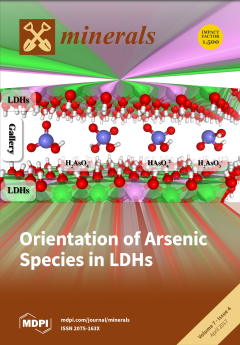Schwertmannite, a kind of iron oxyhydrosulfate mineral, can removal arsenic(III) from arsenic(III)-bearing groundwater by the adsorption process. In this study, schwertmannite was bio-synthesized by
Acidithiobacillus ferrooxidans LX5 in shaking flasks (160 rpm) containing a 0.16 mol/L FeSO
4 liquid solution. After bio-synthesis, 25.5%
[...] Read more.
Schwertmannite, a kind of iron oxyhydrosulfate mineral, can removal arsenic(III) from arsenic(III)-bearing groundwater by the adsorption process. In this study, schwertmannite was bio-synthesized by
Acidithiobacillus ferrooxidans LX5 in shaking flasks (160 rpm) containing a 0.16 mol/L FeSO
4 liquid solution. After bio-synthesis, 25.5% of the bio-synthesized schwertmannite adhered to the reactor wall (designated as adhered-sch) and the remainder was suspended in the system (designated as suspended-sch). Particles of adhered-sch exhibited a fractured structure with a small specific surface area (4.36 m
2/g) and total pore volume (3.13 × 10
−2 cm
3/g). In contrast, suspended-sch had a spiny structure (similar in appearance to a hedgehog), and a larger specific surface area (9.62 m
2/g) and total pore volume (8.01 × 10
−2 cm
3/g). When 0.25 g/L of adhered-sch was used as an adsorbent for arsenic(III) removal from 1 mg/L arsenic(III)-bearing waters (at pH 7.5), the arsenic(III) removal efficiency was 43.2% after 4 h of adsorption. However, this efficiency could be increased by 50% by using suspended-sch as the adsorbent. Furthermore, by adding 13.3 g/L and 26.7 g/L additional schwertmannite into the reactor system prior to schwertmannite bio-synthesis, all synthesized schwertmannite remained suspended in the bio-synthesis systems, and the ferrous ions’ bio-oxidation efficiency was improved to a certain extent. Due to the friction effect between the introduced schwertmannite and the reactor wall, adhered-sch was eliminated. The outcomes of this study will provide the necessary data for schwertmannite bio-synthesis and arsenic(III) removal from arsenic(III)-bearing groundwater.
Full article





